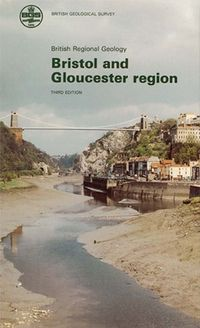British regional geology: Bristol and Gloucester region
The British regional geology: Bristol and Gloucester region has been converted to a series of articles for this wiki. The book is available for purchase at the BGS Online Shop Its full reference is:
| Green, G W. 1992. British regional geology: Bristol and Gloucester region (Third edition). (London: HMSO for the British Geological Survey.) |

Contents
Introduction
Cambrian
Silurian
Old Red Sandstone (Silurian–Carboniferous)
- Stratigraphy
Lower Carboniferous (Dinantian)
- Stratigraphy
Upper Carboniferous (Namurian)
Upper Carboniferous (Westphalian and Stephanian)
Intra-Palaeozoic earth movements
Permo-Triassic
Lower Jurassic
Middle Jurassic (Inferior Oolite Group)
Middle Jurassic (Great Oolite Group)
- Stratigraphy
Middle/Upper Jurassic (Kellaways Beds and Oxford Clay)
Cretaceous
Post-Variscan structure and sedimentation
Quaternary
Economic geology
Foreword to the third edition
The second edition of the Bristol and Gloucester regional guide was produced in 1948, but since that time much new information has been collected and there was a need to produce this third edition to incorporate the information derived from mapping carried out by the British Geological Survey and exploration undertaken by the coal, petroleum and water industries.
The Bristol and Gloucester district is one of the geologically most varied parts of Britain. This in turn provides the scenic variety for which the area is renowned, including the deep gorges of Cheddar Gorge and the Wye Valley, prominent escarpments such as those of the Cotswolds and the Forest of Dean, and the wide valleys flanking the Thames and the Severn. The area is also famous for its caves, such as Wookey Hole. It is the combination of a congenial environment and mineral resources which has attracted people to the Bristol and Gloucester district since the days of early man.
The geology of the district, as outlined in this volume, provides a fascinating insight into the history and evolution of the area, extending back more than 500 million years. The region contains some of the oldest rocks exposed in southern England whilst at the other end of the geological timescale, because the region was located near the edge of the massive ice sheets which at times covered much of Britain, it provides us with a dramatic picture of changing environments over the last two million years.
Elucidating the geological history is essential if we are to understand the controls on the distribution of mineral resources in the region. These resources include lime and aggregate, which are extracted in large quantities, and resources which are not presently mined, such as coal, evaporites, ironstone, clay, lead, (worked from Roman times), zinc and oil shales. Groundwater is one of the most important and widely used resources in the regionthe geological investigations undertaken by the BGS in the region will help to conserve this important resource for present and future generations. Bath and other thermal waters have been the subject of recent investigations which have shown that their composition (and temperature) are closely related to their underlying geology.
The first two editions of this regional guide were very popular and I am confident that the third edition will be equally popular with geologists, planners, environmentalists, explorers, tourists and all those interested in the geological development of this beautiful area and its conservation.
- British Geological Survey
- Keyworth
- Nottingham NG12 5GG
- 1 March 1992
- Peter J Cook, DSc
- Director
Acknowledgements
The author wishes to acknowledge the great help he has received from numerous colleagues on the Survey in writing this account in particular to Dr P M Allen and Mr B J Williams for editing the text, and to members of the palaeontological and petrographical departments for evaluating appropriate sections. Special mention must also be made of Mr R J Wyatt, not only for checking the entire work and seeing it through the press but also for supplying valuable help with Chapter 12 (Great Oolite Group). The figures were prepared by Mr J W Arbon. Thanks are due to the Council of the Geological Society of London for permission to use and adapt Figure 15 (from the Journal of the Geological Society, 1983), and to Messrs Blackie for Figures 32 and 33.